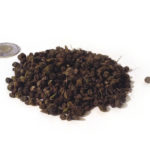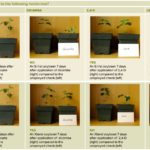Reading Time: 3 minutes [Question]: Find enclosed a sample of oats that I harvested with a considerable amount of eastern black nightshade berries. Is it all right to feed this to my beef cows? [Answer]: If your desire is to have no risk of negative health impacts on your livestock, then do not feed the contaminated oats to your […] Read more

Pest Patrol: Can I feed eastern black nightshade berries to my beef cows?
#PestPatrol with Mike Cowbrough, OMAFRA

Pest Patrol: What have we learned in 2017 for managing glyphosate-resistant Canada fleabane?
#PestPatrol with Mike Cowbrough, OMAFRA, Dr. Clarence Swanton, Dr. François Tardif and Peter Smith, University of Guelph
Reading Time: 2 minutes Multiple strategies are needed to control glyphosate-resistant Canada fleabane. Experience has taught agronomists and farmers that simply tank mixing another mode of action won’t be a good enough long-term approach. Since 2016, we have evaluated different management tactics for Canada fleabane. The following are the results at our Oxford and Norfolk county field locations. Tillage […] Read more

Pest Patrol: Chess moves on winter wheat crop
#PestPatrol with Mike Cowbrough, OMAFRA
Reading Time: 2 minutes [Question:] I had a weed called “chess” in my winter wheat crop at harvest. How did it get here? Is it a problem? And how do I get rid of it? [Answer:] How did it get here? Chess (scientifically known as Bromus secalinus) is also sometimes referred to as “cheat” or “rye brome.” It is […] Read more

Pest Patrol: Why are we looking at the Harrington Seed Destructor?
#PestPatrol with Mike Cowbrough, OMAFRA
Reading Time: 2 minutes The old saying “one year’s seeding makes seven years’ weeding” perfectly captures why most farmers despise uncontrolled weeds and the tens of thousands of seeds that are dispersed across their land. Fortunately a farmer-made invention called the Harrington Seed Destructor (HSD) is able to destroy more than 90 per cent of the seed produced from […] Read more

Pest Patrol: Mixing ‘crop enhancer’ with glyphosate for weed control
#PestPatrol with Mike Cowbrough, OMAFRA
Reading Time: 2 minutes [Question:] I recently received this query. “I have a client who wants to mix a ‘crop enhancer’ with glyphosate to control weeds in glyphosate-tolerant soybeans. According to the manufacturer’s website, this product ‘can be combined with other applications (e.g. fertilizer, herbicides, insecticide, etc.).’ However, when I read the composition of the product, it appears to […] Read more

Preparing for western bean cutworm in 2017
#PestPatrol with Tracey Baute, OMAFRA
Reading Time: 3 minutes Western bean cutworm (WBC) has earned the designation of primary pest of corn in Ontario, and it is starting to become important for dry bean growers too. Quality concerns outweigh yield loss with this pest, and when conditions are conducive to mycotoxins, as in 2016, WBC’s impact is very evident. The flurry of tweets under […] Read more

Pest Patrol: How effective is tillage at controlling glyphosate-resistant Canada fleabane?
#PestPatrol with Mike Cowbrough, OMAFRA
Reading Time: 2 minutes It’s a saying commonly used by advocates who would like to see more tillage used for weed control: “No herbicide resistance can evolve to cold hard steel.” I’m not here to discount the value of tillage for weed control, but this implies that tillage is foolproof. Although tillage can do a reasonably good job at […] Read more

Pest Patrol: How do I get better control of lamb’s quarters?
#PestPatrol with Mike Cowbrough, OMAFRA
Reading Time: 2 minutes Lamb’s quarters has consistently been identified as the most abundant and most problematic weed affecting field crop production in Ontario. Yet the Pest Management Regulatory Agency database contains hundreds of herbicides that list lamb’s quarters as either suppressed or controlled. It’s safe to say there is an arsenal of products available to farmers, but our […] Read more

Pest Patrol: Xtend soybeans, spray drift and controlling glyphosate-resistant fleabane
#PestPatrol with Mike Cowbrough, OMAFRA
Reading Time: 2 minutes I want to plant Roundup Ready 2 Xtend soybeans this season to control my glyphosate-resistant Canada fleabane. But I keep hearing about the increased risk of drift with the dicamba-based herbicides. Is this fear mongering, or do I need to pay special attention when applying herbicides containing dicamba? We can learn a lot about the […] Read more

Pest Patrol: Enlist vs. Extend
#PestPatrol with Mike Cowbrough, OMAFRA
Reading Time: 2 minutes What is the difference between Enlist and Roundup Ready 2 Xtend soybeans, and how good are they at controlling glyphosate-resistant weeds? The key selling point of each new seed system is that they have tolerance to specific “auxinic” herbicides that traditionally have been used to control weeds in corn and cereals, and in theory should […] Read more


